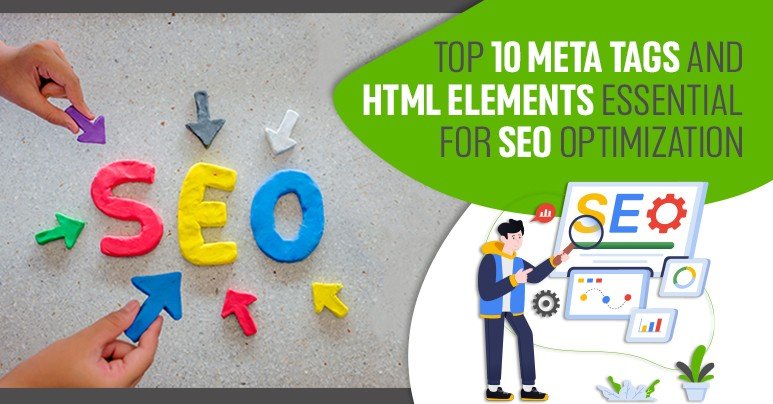Enhance your website's search engine visibility with Meta Tags and HTML Elements. Discover how to optimize Meta tags to create compelling search snippets and drive traffic to your site.
HTML Meta tags have long been recognized as vital components of SEO. This remains true today.
While producing quality content, attracting backlinks, and refining page layouts are important, they are significantly enhanced by proper utilization of HTML tags.
Google's John Mueller has affirmed that while Google doesn't use HTML Meta tags for rankings, they do impact the creation of SERP snippets, which in turn influence click-through rates. Hence, Meta tags warrant careful attention for generating traffic.
HTML tags efficiently communicate a page's content to Google, making them indispensable for SEO success.
Moreover, misusing HTML Meta tags can lead to a drop in rankings, underlining their importance.
Let's delve into the top 10 HTML Meta tags you should utilize on your site. Pay close attention and adopt best practices.
1. Title Tags
The title tag serves as the primary anchor for your page.
Typically appearing as a clickable headline in SERPs, the <title> element also displays on social networks and in browsers.
Crafted within the <head> section of your webpage, title tags offer a succinct and accurate overview of the page's content.
Although the direct impact on rankings has diminished, title tags remain crucial for engaging searchers and influencing click-through rates.
Adhere to these best practices:
• Provide each page with a unique, concise title.
• Limit titles to 50-60 characters to avoid truncation.
• Prioritize important keywords naturally.
• Incorporate your brand name for added visibility.
2. Meta Description Tags
Situated within the <head> section, Meta descriptions often accompany SERP snippets alongside titles and URLs.
Craft a compelling Meta description that encapsulates your page's value proposition.
While Meta descriptions don't directly influence rankings, they significantly impact click-through rates and user engagement.
Follow these guidelines for optimal Meta descriptions:
• Create unique descriptions reflecting the page's value.
• Limit Meta descriptions to 150-160 characters.
• Include significant keywords naturally.
• Avoid keyword stuffing and incorporate a persuasive call-to-action when applicable.
3. Robots Meta Tag
Utilize the robots Meta tag to control indexing and crawling behavior.
The "noindex" attribute prevents search engines from indexing a page, while "nofollow" instructs them not to follow links on the page.
Although not directly tied to rankings, these tags play a vital role in managing site visibility and crawl budget.
Adhere to these best practices:
• Close unnecessary or unfinished pages with thin content.
• Prevent pages from consuming crawl budget unnecessarily.
• Exercise caution to avoid mistakenly restricting important pages from indexing.
4. rel="canonical" Link Tag
Implement the rel="canonical" link tag to specify the preferred version of a page for indexing.
This tag resolves duplicate content issues and consolidates link signals to the preferred URL.
Ensure proper implementation for optimal SEO outcomes:
• Canonicalize pages with similar or duplicate content.
• Use canonical tags judiciously to avoid misleading search engines.
5. Social Media Meta Tags
Leverage Open Graph and Twitter card tags to control how your pages appear on social media platforms.
Customize metadata to enhance link appearance and drive engagement.
While social media Meta tags don't impact search engine rankings, they significantly influence click-through rates and user experience.
Adopt these best practices:
• Incorporate basic metadata using Open Graph protocol.
• Configure and validate Twitter cards for enhanced visibility.
6. Schema Mark-up
Implement schema mark-up to organize data on your web pages, aiding search engines in understanding content.
Structured data mark-up improves user experience, enhances content understanding, and increases chances of appearing in SERP features.
Follow these steps for effective schema mark-up:
• Study available schemas on schema.org.
• Map relevant concepts to your pages.
• Implement mark-up carefully and test thoroughly.
7. Heading Tags (H1-H6)
Utilize heading tags to structure and organize content effectively.
While H1 tags carry more weight, proper usage of all heading tags contributes to better content organization and user experience.
Ensure relevance and moderation in heading tag usage for optimal SEO outcomes.
8. HTML5 Semantic Tags
Leverage HTML5 semantic tags to improve content indexing and understanding.
Adopt HTML5 tags appropriately to convey content structure effectively to search engines.
Utilize HTML5 tags correctly to facilitate content indexing and enhance SEO.
9. Image Alt Attributes
Optimize image alt attributes to provide context and improve accessibility.
Craft descriptive alt text that accurately reflects image content and enhances relevance.
Optimize alt attributes for prominent images to improve search engine visibility.
10. Nofollow Attributes
Implement nofollow attributes to control link equity and manage outbound links effectively.
Use nofollow attributes judiciously to prevent manipulative linking tactics and preserve site integrity.
Ensure a healthy balance between followed and nofollowed links for optimal SEO performance.
In conclusion, HTML Meta tags and elements are foundational to effective SEO strategies. By adhering to best practices and leveraging these elements appropriately, you can enhance your website's search engine visibility and drive organic traffic. Stay updated with evolving SEO trends and incorporate new tags to stay ahead in the digital landscape.





